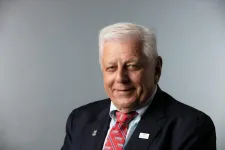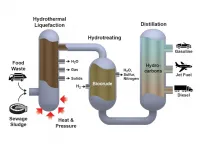Planting trees to save the planet: The Chinese experience
2021-03-25
(Press-News.org) A coordinated global effort to reduce the production of greenhouse gas emissions from industry and other sectors may not stop climate change, but Earth has a powerful ally that humans might partner with to achieve carbon neutrality: Mother Nature. An international team of researchers called for the use of natural climate solutions to help "cancel" produced emissions and remove existing emissions as part of a comprehensive plan to keep global warming below 1.5 degrees Celsius -- the point at which damage to human life and livelihoods could become catastrophic, according to the United Nations' Intergovernmental Panel on Climate Change.
The researchers published their invited views on March 24 in Advances in Atmospheric Sciences. "The Earth is heating up, and climate change has become a major environmental concern for the whole planet," said first author Dr. Zhangcai Qin, professor at Sun Yat-sen University and Southern Marine Science and Engineering Guangdong Laboratory (Zhuhai). "In this work, we want to highlight the important role of nature and human action in mitigating climate change."
Called natural climate solutions, largely land-based ecosystems, such as forests, agriculture, grasslands and wetlands, could sequester carbon emissions from industry and store them in trees, grass and soil. While the energy and industrial sectors are essential in their commitment to reduce emissions, Qin said, they are both insufficient and unable to rectify already emitted gases.
"Natural climate solutions have been recognized as one of the most cost-effective and readily available options that can be used to supplement energy and industrial mitigation in the climate portfolio," Qin said.
He pointed to China, which has launched several nationwide ecological projects over the past half century, as an example of success, although these projects were not intended as natural climate solutions at the time they were initiated. The Natural Forest Protection Project, for instance, was implemented to help mitigate mass flooding in 1998 but has since contributed to more than half of the country's natural carbon sinks.
"China started its first major projects in the 1970s, and it took over 40 years and several phases to finally reshape its degraded landscapes," Qin said. "China provides invaluable experience and lessons with a long history of natural climate solutions. Studying China's past experiences offers a shortcut to learning how Mother Nature can help us deal with climate change. However, one of the biggest challenges to scaling up China's experience is delayed action. We need to act and act fast before it is too late."
According to Qin's team, the use of natural carbon solutions, if managed properly under local and global guidance, could result in achievable mitigation of the equivalent of nearly 15 trillion pounds of greenhouse gases per year -- which would account for more than 10% of current global annual greenhouse gas emissions. That's more than a quarter of the annual global emissions reduction of 50% needed in the next 10 years to reach net zero by the 2050s, as set out in the Paris Climate Agreement. This figure, the most conservative, accounts for potential delays as projects get underway, as well as pauses to navigate the challenges. If the delays can be minimized, the mitigation potential could be even larger for natural climate solutions, according to Qin's earlier publication.
Qin and the team are now establishing a systematic and comprehensive evaluation strategy for large-scale natural climate solutions to help avoid any potential failures in an effort to help advance mitigation efforts.
"We call for global collaboration and immediate actions in natural climate solutions," Qin said. "This is our best shot to achieve a carbon neutral society globally."
INFORMATION:
Co-authors include Xi Deng and Wenping Yuan, also with Sun Yat-sen University; Bronson Griscom, Conservation International in the United States; Yao Huang, Institute of Botany, CAS; Tingting Li and Wen Zhang, Institute of Atmospheric Physics, CAS; and Pete Smith, Institute of Biological and Environmental Sciences, University of Aberdeen in the United Kingdom.
The National Basic Research Program of China, the National Natural Science Foundation of China, the Guangdong Province Key Laboratory for Climate Change and Natural Disaster Studies and the Guangdong Provincial Department of Science and Technology funded this work.
[Attachments] See images for this press release:

ELSE PRESS RELEASES FROM THIS DATE:
2021-03-25
Recently, the team led by Professor WU Changzheng from School of Chemistry and Materials Science from University of Science and Technology of China (USTC) in cooperation with the team led by Prof. WU Hengan from School of Engineering Science, realized the homogenization of surface active sites of heterogeneous catalyst by dissolving the electrocatalytic active metal in molten gallium. The related results have been published on the Nature Catalysis on March 11th.
Due to the existence of various defects and crystal faces, the active components on the surface of heterogeneous catalysts are often in different ...
2021-03-25
Tsukuba, Japan - Physical exercise has long been prescribed as a way to improve the quality of sleep. But now, researchers from Japan have found that even when exercise causes objectively measured changes in sleep quality, these changes may not be subjectively perceptible.
In a study published this month in Scientific Reports, researchers from the University of Tsukuba have revealed that vigorous exercise was able to modulate various sleep parameters associated with improved sleep, without affecting subjective reports regarding sleep quality.
Exercise is ...
2021-03-25
Lugano, Switzerland; Denver, CO, USA, 25 March 2021 - Clinical activity with a second drug inhibiting KRASG12C confirms its role as a therapeutic target in patients with advanced non-small-cell lung cancer (NSCLC) harbouring this mutation, according to results from a study with the KRASG12C inhibitor adagrasib reported at the European Lung Cancer Virtual Congress 2021. (1)
"As we strive to identify the oncogenic driver in more and more of our patients with NSCLC, it becomes critical that we develop therapies that can target these identified oncogenic drivers," said lead author Gregory Riely, from Memorial Sloan Kettering Cancer Center, New York, ...
2021-03-25
For the first time, activation of nuclear receptor coactivator 3 (NCOA3) has been shown to promote the development of melanoma through regulation of ultraviolet radiation (UVR) sensitivity, cell cycle progression and circumvention of the DNA damage response. Results of a pre-clinical study led by Mohammed Kashani-Sabet, M.D., Medical Director of the Cancer Center at Sutter's California Pacific Medical Center (CPMC) in San Francisco, CA were published online today in Cancer Research, a journal of the American Association for Cancer Research.
"Our research suggests a previously unreported mechanism by which NCOA3 regulates the DNA damage response and acts as a potential therapeutic target in melanoma, whereby activation ...
2021-03-25
Durham, NC - Depletion of a certain type of stem cell in the womb lining during pregnancy could be a significant factor behind miscarriage, according to a study released today in STEM CELLS. The study, by researchers at Warwick Medical School, University of Warwick, Coventry, England, reports on how recurrent pregnancy loss is a result of the loss of decidual precursor cells prior to conception.
"This raises the possibility that they can be harnessed to prevent pregnancy disorders," said corresponding author Jan J. Brosens, M.D., Ph.D., professor of obstetrics and gynecology at Warwick Medical School (WMS).
The womb lining - or endometrium - is a ...
2021-03-25
Perhaps the best hope for slowing climate change - capturing and storing carbon dioxide emissions underground - has remained elusive due in part to uncertainty about its economic feasibility.
In an effort to provide clarity on this point, researchers at Stanford University and Carnegie Mellon University have estimated the energy demands involved with a critical stage of the process. (Watch video here: https://www.youtube.com/watch?v=-ZPIwwQs9aM)
Their findings, published April 8 in Environmental Science & Technology, suggest that managing and ...
2021-03-25
Smoking cigarettes causes 480,000 premature deaths each year in the United States, due mainly to a two-fold risk of cardiovascular disease and a 20-fold risk of lung cancer. Although smoking rates have declined dramatically, there are currently 35 million smokers in the U.S.
In a commentary published in the Ochsner Medical Journal, Charles H. Hennekens, M.D., Dr.PH, senior author, the First Sir Richard Doll Professor, and senior academic advisor in the Schmidt College of Medicine at Florida Atlantic University, and colleagues, highlight how failure to institute smoking cessation in hospitalized patients is a missed opportunity to avoid many premature deaths.
Each year in the U.S., ...
2021-03-25
An international team led by scientists at the National Institutes of Health and the University of North Carolina at Chapel Hill, has found evidence that SARS-CoV-2, the virus that causes COVID-19, infects cells in the mouth.
While it's well known that the upper airways and lungs are primary sites of SARS-CoV-2 infection, there are clues the virus can infect cells in other parts of the body, such as the digestive system, blood vessels, kidneys and, as this new study shows, the mouth. The potential of the virus to infect multiple areas of the body might help explain the wide-ranging symptoms experienced by COVID-19 patients, including oral symptoms such as taste loss, dry mouth and blistering.
Moreover, the findings ...
2021-03-25
RICHLAND, WASH.--A large-scale demonstration converting biocrude to renewable diesel fuel has passed a significant test, operating for more than 2,000 hours continuously without losing effectiveness. Scientists and engineers led by the U.S. Department of Energy's Pacific Northwest National Laboratory conducted the research to show that the process is robust enough to handle many kinds of raw material without failing.
"The biocrude oil came from many different sources, including wastewater sludge from Detroit, and food waste collected from prison and an army base," said John Holladay, a PNNL scientist and co-director of the joint Bioproducts Institute, a collaboration between ...
2021-03-25
LA JOLLA--(March 25, 2021) The brush of an insect's wing is enough to trigger a Venus flytrap to snap shut, but the biology of how these plants sense and respond to touch is still poorly understood, especially at the molecular level. Now, a new study by Salk and Scripps Research scientists identifies what appears to be a key protein involved in touch sensitivity for flytraps and other carnivorous plants.
The findings, published March 16, 2021, in the journal eLife, help explain a critical process that has long puzzled botanists. This could help scientists better understand how plants of all kinds sense and respond to mechanical stimulation, and could also have a potential application in medical therapies that mechanically stimulate human cells such as neurons.
"We know that plants ...
LAST 30 PRESS RELEASES:
[Press-News.org] Planting trees to save the planet: The Chinese experience




